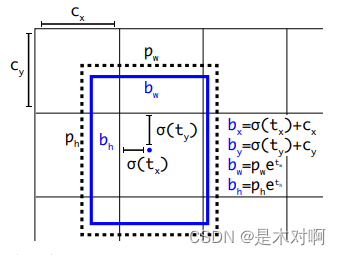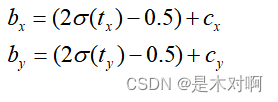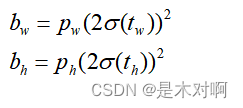(1)损失函数
YOLOv5的损失主要由三个部分组成:
Classes loss,分类损失,采用BCE loss,只计算正样本的分类损失。Objectness loss,obj置信度损失,采用BCE loss,计算的是所有样本的obj损失。注意这里的obj指的是网络预测的目标边界框与GT Box的CIoU。Location loss,定位损失,采用CIoU loss,只计算正样本的定位损失。
针对三个预测特征层(P3, P4, P5)上的obj损失采用不同的权重。在源码中,针对预测小目标的预测特征层(P3)采用的权重是4.0,针对预测中等目标的预测特征层(P4)采用的权重是1.0,针对预测大目标的预测特征层(P5)采用的权重是0.4。
self.balance = {3: [4.0, 1.0, 0.4]}.get(det.nl, [4.0, 1.0, 0.25, 0.06, .02]) # P3-P7lobj += obji * self.balance[i] # obj loss(2)边界框计算公式(消除grid敏感度)
详情见YOLOv5网络详解
原来边界框计算公式:

tx,ty为网络预测的目标中心点距离栅格左上点的偏移量,σ为sigmoid函数,将预测的偏移量限制在0到1之间,即预测的中心点不会超出对应的栅格区域。
YOLOv5作者将偏移的范围由原来的( 0 , 1 )调整到了( − 0.5 , 1.5 ):

目标宽高的计算公式调整为:

调整后倍率因子被限制在( 0 , 4 ) 之间,对预测目标的宽高做了限制。
pxy = ps[:, :2].sigmoid() * 2. - 0.5pwh = (ps[:, 2:4].sigmoid() * 2) ** 2 * anchors[i]pbox = torch.cat((pxy, pwh), 1) # predicted box(3)匹配样本方式
①:根据GT Box与对应的Anchor Templates模板的高宽比例(0.25~4)进行匹配。
②:栅格左上角点距离GT中心点在( − 0.5 , 1.5 ) 范围,它们对应的Anchor都能回归到GT的位置,这样会让正样本的数量得到大量的扩充。
损失函数的代码注释,主要参考:
【YOLOV5-5.x 源码解读】loss.py
yolov5 build_targets()
class ComputeLoss: # Compute losses def __init__(self, model, autobalance=False): super(ComputeLoss, self).__init__() self.sort_obj_iou = False # 筛选置信度损失的时候是否先对iou排序 device = next(model.parameters()).device # get model device h = model.hyp # hyperparameters # Define criteria:Binary Cross Entropy BCEcls = nn.BCEWithLogitsLoss(pos_weight=torch.tensor([h['cls_pw']], device=device)) # 分类损失 BCEobj = nn.BCEWithLogitsLoss(pos_weight=torch.tensor([h['obj_pw']], device=device)) # 置信度损失 # Class label smoothing https://arxiv.org/pdf/1902.04103.pdf eqn 3 self.cp, self.cn = smooth_BCE(eps=h.get('label_smoothing', 0.0)) # positive, negative BCE targets 1, 0 # Focal loss g = h['fl_gamma'] # focal loss gamma = 0 if g > 0: BCEcls, BCEobj = FocalLoss(BCEcls, g), FocalLoss(BCEobj, g) # det: 返回的是模型的检测头 Detector 3个 分别对应产生三个输出feature map det = model.module.model[-1] if is_parallel(model) else model.model[-1] # Detect() module self.balance = {3: [4.0, 1.0, 0.4]}.get(det.nl, [4.0, 1.0, 0.25, 0.06, .02]) # P3-P7 预测特征层的置信度损失系数 self.ssi = list(det.stride).index(16) if autobalance else 0 # stride 16 index # 0 self.BCEcls, self.BCEobj, self.gr, self.hyp, self.autobalance = BCEcls, BCEobj, 1.0, h, autobalance for k in 'na', 'nc', 'nl', 'anchors': setattr(self, k, getattr(det, k)) # 讲det的k属性赋值给self.k属性 def __call__(self, p, targets): # predictions, targets, model device = targets.device # 初始化lcls, lbox, lobj三种损失值 tensor([0.]) lcls, lbox, lobj = torch.zeros(1, device=device), torch.zeros(1, device=device), torch.zeros(1, device=device) tcls, tbox, indices, anchors = self.build_targets(p, targets) # targets # 参考build_targets函数 # Losses # 依次遍历三个feature map的预测输出pi for i, pi in enumerate(p): # layer index, layer predictions b, a, gj, gi = indices[i] # image, anchor, gridy, gridx tobj = torch.zeros_like(pi[..., 0], device=device) # target obj # 初始化target置信度(先全是负样本 后面再筛选正样本赋值) n = b.shape[0] # number of targets if n: # 精确得到b图片,a anchor,grid_cell(gi, gj)对应的预测值 # 用这个预测值与我们筛选的这个grid_cell的真实框进行预测(计算损失) ps = pi[b, a, gj, gi] # prediction subset corresponding to targets # Regression pxy = ps[:, :2].sigmoid() * 2. - 0.5 pwh = (ps[:, 2:4].sigmoid() * 2) ** 2 * anchors[i] pbox = torch.cat((pxy, pwh), 1) # predicted box # 这里的tbox[i]中的xy是这个target对当前grid_cell左上角的偏移量[0,1] 而pbox.T是一个归一化的值 iou = bbox_iou(pbox.T, tbox[i], x1y1x2y2=False, CIoU=True) # iou(prediction, target) lbox += (1.0 - iou).mean() # iou loss 定位损失 # Objectness # iou.detach() 不会更新iou梯度 iou并不是反向传播的参数 所以不需要反向传播梯度信息 score_iou = iou.detach().clamp(0).type(tobj.dtype) if self.sort_obj_iou: sort_id = torch.argsort(score_iou) b, a, gj, gi, score_iou = b[sort_id], a[sort_id], gj[sort_id], gi[sort_id], score_iou[sort_id] # self.gr是iou ratio [0, 1] self.gr越大,置信度越接近iou self.gr越小,置信度越接近1(人为加大训练难度) tobj[b, a, gj, gi] = (1.0 - self.gr) + self.gr * score_iou # iou ratio # Classification if self.nc > 1: # cls loss (only if multiple classes) t = torch.full_like(ps[:, 5:], self.cn, device=device) # targets t[range(n), tcls[i]] = self.cp # 筛选到的正样本对应位置值是cp 1 lcls += self.BCEcls(ps[:, 5:], t) # BCE 分类损失 # Append targets to text file # with open('targets.txt', 'a') as file: # [file.write('%11.5g ' * 4 % tuple(x) + '\n') for x in torch.cat((txy[i], twh[i]), 1)] # 置信度损失是用所有样本(正样本 + 负样本)一起计算损失的 obji = self.BCEobj(pi[..., 4], tobj) lobj += obji * self.balance[i] # obj loss 置信度损失 if self.autobalance: self.balance[i] = self.balance[i] * 0.9999 + 0.0001 / obji.detach().item() if self.autobalance: self.balance = [x / self.balance[self.ssi] for x in self.balance] lbox *= self.hyp['box'] lobj *= self.hyp['obj'] lcls *= self.hyp['cls'] bs = tobj.shape[0] # batch size return (lbox + lobj + lcls) * bs, torch.cat((lbox, lobj, lcls)).detach() def build_targets(self, p, targets): # Build targets for compute_loss(), input targets(image,class,x,y,w,h) """ Build targets for compute_loss() params p: p[i]的作用只是得到每个feature map的shape 预测框由模型构建中的三个检测头Detector返回的三个yolo层的输出 tensor格式list列表 存放三个tensor 对应的是三个yolo层的输出 如: [4, 3, 80, 80, 7]、[4, 3, 40, 40, 7]、[40, 3, 20, 20, 7] [bs, anchor_num, grid_h, grid_w, xywh+class置信度+classes某一类别对应概率] 可以看出来这里的预测值p是三个yolo层每个grid_cell(每个grid_cell有三个预测值)的预测值,后面肯定要进行正样本筛选 params targets: 数据增强后的真实框 [2, 6] [num_target, image_index+class+xywh] xywh为归一化后的框 return tcls: 表示这个target所属的class index tbox: xywh 其中xy为这个target对当前grid_cell左上角的偏移量 indices: b: 表示这个target属于的image index a: 表示这个target使用的anchor index gj: 经过筛选后确定某个target在某个网格中进行预测(计算损失) gj表示这个网格的左上角y坐标 gi: 表示这个网格的左上角x坐标 anch: 表示这个target所使用anchor的尺度(相对于这个feature map) 注意可能一个target会使用大小不同anchor进行计算 """ #此处为自己设置的targets # target = torch.tensor([[0.00000, 1.00000, 0.54517, 0.33744, 0.06395, 0.02632], # [1.00000, 0.00000, 0.96964, 0.42483, 0.06071, 0.05264]]) na, nt = self.na, targets.shape[0] # number of anchors 3, targets 我们这里设为2进行debug,如上 tcls, tbox, indices, anch = [], [], [], [] gain = torch.ones(7, device=targets.device) # normalized to gridspace gain tensor([1., 1., 1., 1., 1., 1., 1.]) ai = torch.arange(na, device=targets.device).float().view(na, 1).repeat(1, nt) # same as .repeat_interleave(nt) # tensor([[0., 0.], # [1., 1.], # [2., 2.]]) # 一个特征图对应3个anchor, 将target复制3份并在后面添加anchor索引,表示当前target对应哪个anchor targets = torch.cat((targets.repeat(na, 1, 1), ai[:, :, None]), 2) # append anchor indices # targets: tensor([[[0.0000, 1.0000, 0.5452, 0.3374, 0.0640, 0.0263, 0.0000], # [1.0000, 0.0000, 0.9696, 0.4248, 0.0607, 0.0526, 0.0000]], # [[0.0000, 1.0000, 0.5452, 0.3374, 0.0640, 0.0263, 1.0000], # [1.0000, 0.0000, 0.9696, 0.4248, 0.0607, 0.0526, 1.0000]], # [[0.0000, 1.0000, 0.5452, 0.3374, 0.0640, 0.0263, 2.0000], # [1.0000, 0.0000, 0.9696, 0.4248, 0.0607, 0.0526, 2.0000]]]) g = 0.5 # bias off = torch.tensor([[0, 0], [1, 0], [0, 1], [-1, 0], [0, -1], # j,k,l,m # [1, 1], [1, -1], [-1, 1], [-1, -1], # jk,jm,lk,lm ], device=targets.device).float() * g # offsets # tensor([[ 0.0000, 0.0000], # [ 0.5000, 0.0000], # [ 0.0000, 0.5000], # [-0.5000, 0.0000], # [ 0.0000, -0.5000]]) # 遍历三个feature map,为target筛选anchor正样本 for i in range(self.nl): # self.nl: number of detection layers Detect的个数 = 3 anchors = self.anchors[i] # 假设anchors = torch.tensor([[1.25000, 1.62500], anchor1 # [2.00000, 3.75000], anchor2 # [4.12500, 2.87500]]) anchor3 gain[2:6] = torch.tensor(p[i].shape)[[3, 2, 3, 2]] # xyxy gain # gain = torch.tensor([ 1., 1., 20., 20., 20., 20., 1.]) 假设现在是在20*20大小的特征图上进行预测 # Match targets to anchors t = targets * gain #将target中的xywh归一化尺度放大到当前feature map的坐标尺度, x,y,w,h都乘以20 if nt: # Matches r = t[:, :, 4:6] / anchors[:, None] # wh ratio # r: tensor([[[1.0232, 0.3239], target0与anchor0的宽高比 1.0232=target0的宽度/anchor0的宽度 # [0.9714, 0.6479]], target1与anchor0的宽高比 # [[0.6395, 0.1404], target0与anchor1的宽高比 # [0.6071, 0.2807]], target1与anchor1的宽高比 # [[0.3101, 0.1831], target0与anchor2的宽高比 # [0.2944, 0.3662]]]) target1与anchor2的宽高比 j = torch.max(r, 1. / r).max(2)[0] < self.hyp['anchor_t'] # compare 宽度和高度方向差异最大的值与设定值的比较 # tensor([[ True, True], 第一个True表示target0与anchor0最大的宽高比<设定值 第一个True表示target1与anchor0最大的宽高比<设定值 # [False, True], # [False, True]]) # 最后的结果target0分给anchor0,target1分给anchor0,anchor1,anchor2 t = t[j] # filter # t: tensor([[ 0.0000, 1.0000, 10.9034, 6.7488, 1.2790, 0.5264, 0.0000], # [ 1.0000, 0.0000, 19.3928, 8.4966, 1.2142, 1.0528, 0.0000], # [ 1.0000, 0.0000, 19.3928, 8.4966, 1.2142, 1.0528, 1.0000], # [ 1.0000, 0.0000, 19.3928, 8.4966, 1.2142, 1.0528, 2.0000]]) # Offsets gxy = t[:, 2:4] # grid xy # 相对feature map左上角的目标 gxi = gain[[2, 3]] - gxy # inverse # 相对feature map右下角的目标 j, k = ((gxy % 1. < g) & (gxy > 1.)).T # 如gxy%1<0.5,就表示其小数部分<0.5,则更靠近左上,并且忽略第一行和第一列的格子 l, m = ((gxi % 1. < g) & (gxi > 1.)).T # 如gxi%1<0.5,就表示gxy的小数部分>0.5,靠近右下,并忽略最后一行和最后一列的格子 j = torch.stack((torch.ones_like(j), j, k, l, m)) # tensor([[ True, True, True, True], # [False, True, True, True], j如果是True表示当前target中心点所在的格子的左边格子也对该target进行回归(后续进行计算损失) # [False, True, True, True], k如果是True表示当前target中心点所在的格子的上边格子也对该target进行回归(后续进行计算损失) # [ True, False, False, False], l如果是True表示当前target中心点所在的格子的右边格子也对该target进行回归(后续进行计算损失) # [ True, False, False, False]]) m如果是True表示当前target中心点所在的格子的右边格子也对该target进行回归(后续进行计算损失) t = t.repeat((5, 1, 1))[j] # t: tensor([[ 0.0000, 1.0000, 10.9034, 6.7488, 1.2790, 0.5264, 0.0000], # [ 1.0000, 0.0000, 19.3928, 8.4966, 1.2142, 1.0528, 0.0000], # [ 1.0000, 0.0000, 19.3928, 8.4966, 1.2142, 1.0528, 1.0000], # [ 1.0000, 0.0000, 19.3928, 8.4966, 1.2142, 1.0528, 2.0000], # [ 1.0000, 0.0000, 19.3928, 8.4966, 1.2142, 1.0528, 0.0000], # [ 1.0000, 0.0000, 19.3928, 8.4966, 1.2142, 1.0528, 1.0000], # [ 1.0000, 0.0000, 19.3928, 8.4966, 1.2142, 1.0528, 2.0000], # [ 1.0000, 0.0000, 19.3928, 8.4966, 1.2142, 1.0528, 0.0000], # [ 1.0000, 0.0000, 19.3928, 8.4966, 1.2142, 1.0528, 1.0000], # [ 1.0000, 0.0000, 19.3928, 8.4966, 1.2142, 1.0528, 2.0000], # [ 0.0000, 1.0000, 10.9034, 6.7488, 1.2790, 0.5264, 0.0000], # [ 0.0000, 1.0000, 10.9034, 6.7488, 1.2790, 0.5264, 0.0000]]) ''' 对t复制5份,即本身点外加上下左右四个候选区共五个区域,选出三份 具体选出哪三份由torch.stack后的j决定,第一项是torch.ones_like,即全1矩阵,说明本身是必选中状态的。 剩下的4项中,由于是inverse操作,所以j和l,k和m是两两互斥的。 ''' offsets = (torch.zeros_like(gxy)[None] + off[:, None])[j] # offsets tensor([[ 0.0000, 0.0000], # [ 0.0000, 0.0000], # [ 0.0000, 0.0000], # [ 0.0000, 0.0000], # [ 0.5000, 0.0000], # [ 0.5000, 0.0000], # [ 0.5000, 0.0000], # [ 0.0000, 0.5000], # [ 0.0000, 0.5000], # [ 0.0000, 0.5000], # [-0.5000, 0.0000], # [ 0.0000, -0.5000]]) else: t = targets[0] offsets = 0 # Define b, c = t[:, :2].long().T # image, class gxy = t[:, 2:4] # grid xy gwh = t[:, 4:6] # grid wh gij = (gxy - offsets).long() gi, gj = gij.T # grid xy indices # Append a = t[:, 6].long() # anchor indices indices.append((b, a, gj.clamp_(0, gain[3] - 1), gi.clamp_(0, gain[2] - 1))) # image, anchor, grid indices gj: 网格的左上角y坐标 gi: 网格的左上角x坐标 tbox.append(torch.cat((gxy - gij, gwh), 1)) # box:xywh,其中xy为这个target对当前grid_cell左上角的偏移量,0~1之间 anch.append(anchors[a]) # anchors tcls.append(c) # class return tcls, tbox, indices, anch